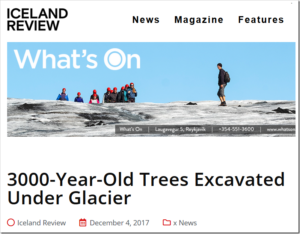by P. Homewood, December 12, 2019 in NotaLotofPeopleKnowThat

Ancient tree stumps found under Breiðamerkurjökull glacier in Southeast Iceland are confirmed to be roughly 3,000 years old. RÚV reports.
A specialist believes the remarkably well-preserved stumps were part of a massive forest that disappeared after a long period of a warm climate.
One of the tree stumps was found in Breiðamerkursandur a couple of months ago, and once it was being salvaged a second, larger one was found. The smaller one was sent for examination while the larger will be examined at a later time.
Examinations revealed that the tree stump died very quickly at 89-years-old in the month of June. Nearby sediments and data suggest that the glacier itself was the culprit.
The tree stumps are from a period when Iceland was covered in forests. Even though 9th century Norse settlers reported vast forests across the country, it is believed that 3,000 years ago, the forests were much larger, even reaching the highlands. Approximately 500 BC, the climate became colder and glaciers began to form, destroying parts of the forests.
The 3,000-year-old remains of the forest are very well preserved and will be researched thoroughly. “It is absolutely incredible just how well preserved this tree stump is, having been buried under a glacier and that it still looks so whole, as opposed to being all wrinkled up like many of the specimens we have found.” Once examinations conclude, the water will be extracted from the tree stump and it will be filled with wax instead, allowing it to be exhibited.
https://www.icelandreview.com/news/3000-year-old-trees-excavated-under-glacier/
Discovering ancient forests under receding glaciers is not confined to Iceland. Remains of trees dating back to the Middle Ages have been found under the Juneau and Exit Glaciers in Alaska, as well under glaciers in Patagonia.
Tree stumps have also turned up under Swiss glaciers, carbon dated to about 4000 years ago.
The simple reality is that glaciers worldwide expanded enormously during the Little Ice Age, arguably to their greatest extent since the Ice Age. Despite decades of retreat since the 19thC, they are still abnormally large by historical standards.

